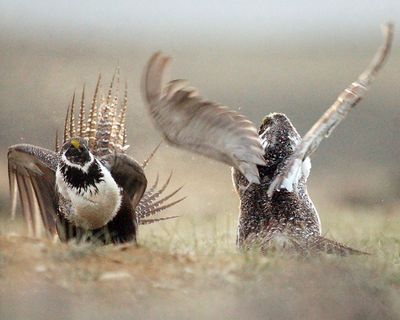Deel may keep sage grouse off endangered species list

As native sage grouse enter their mating season on the sage lands of the West, a deal is being forged to perpetuate the spectacle.
Hoping to keep sage grouse from the endangered species list, ranchers in Eastern Oregon are working on a first-in-the-nation deal that would lay out voluntary steps to reduce the harm to sage grouse on 10 million acres of federal grazing lands.
“The livestock industry knows this is an important issue, and wants to be in position to somewhat control our destiny,” said John O’Keefe, a Warner Valley rancher and sage grouse coordinator for the Oregon Cattlemen’s Association.
The Oregon Cattlemen’s Association is looking into signing a conservation agreement with the U.S. Bureau of Land Management and the U.S. Fish and Wildlife Service in Oregon that would be the first in the nation covering sage grouse, sometimes called the spotted owl of the range because of its potential to force cutbacks in grazing and energy development.
Though BLM has conservation agreements for other species, this would be the first for sage grouse, said BLM spokesman Jeff Clark.
“Our goal is to not have (the bird) get listed,” BLM biologist Glenn Frederick said. “There are measures the rancher can do above and beyond regulatory measures that can help the bird. That is what this is about.”
It is anyone’s guess how many Oregon ranchers sign up once the agreement goes into effect.
The BLM has run into trouble for turning a blind eye to sage grouse in favor of ranchers. In Idaho, a federal judge ruled last year that BLM violated its primary range management law by allowing grazing on five allotments in Owyhee County without first assessing the harm to sage grouse.
As the result of a lawsuit settlement, the sage grouse is one of nearly 200 species that Fish and Wildlife has declared deserve protection, but must wait their turns to be formally considered. The sage grouse’s turn comes in 2015, by which time states and federal agencies hope they will have done enough to make that step unnecessary.
Frederick said details of the Oregon agreement include measures to keep people and livestock away from leks and nesting areas where sage grouse gather at crucial times, and to reduce the numbers of birds killed or injured from flying into wire fences by putting white plastic markers on them.
Brent Fenty of the Oregon Natural Desert Association, said the agreement was unlikely to include one of the most important steps for protecting the bird, taking cattle off range that has been overgrazed.
Last August, Fish and Wildlife issued a report spelling out how sage brush should be managed in 11 Western states to avoid listing them under the Endangered Species Act.
“Federal land grazing is one big part of the picture for sage grouse,” said Paul Henson, Oregon director for Fish and Wildlife. “If you get to the point of actually having to list something, it means you’ve failed at addressing those threats, if you have the opportunity to do it.”
Governors in several states have named taskforces to promote sage brush conservation.
However, populations have been robust enough in some places that Oregon and several other states still allow hunting.
That gives O’Keefe hope that if enough ranchers step up and sign the agreement, they can avoid even tougher limits in the future.
“We feel this is a better vehicle to ready ourselves, hopefully, to prevent the need for a listing, but in the absence of that, provide some management certainty in the event of a listing,” he said.